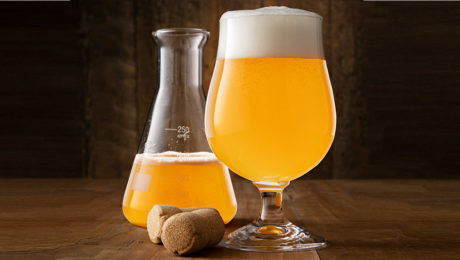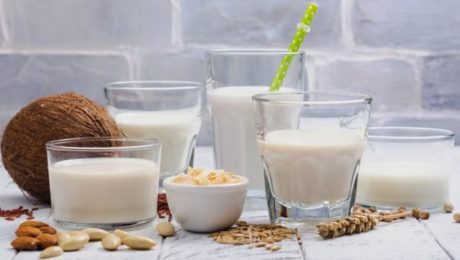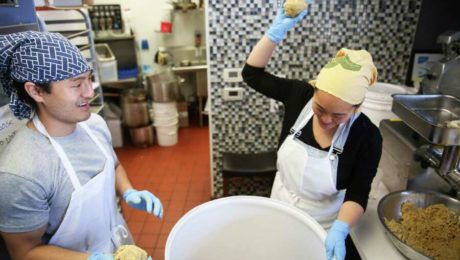Mixed Culture Beer Fermentation
Just because you’ve pitched an exotic fermenting agent into your beer doesn’t mean the hard work is done. Mixed-culture fermentations are becoming increasingly popular choices for brewers looking to add complexity to their beers. But, as an article in Craft Beer & Brewing details, using a mixed array of yeasts and bacteria requires greater attention to the fermentation process.
“Just because it’s a wild beer doesn’t mean that you can be careless,” says Patrick Chavanelle, R&D brewer at Allagash in Portland, Maine. “Be as meticulous when crafting a mixed-fermentation beer as you would when brewing a beautifully crisp lager.”
Mixed fermentation uses multiple microorganisms as fermenting agents. The most common are yeasts Saccharomyces (known as brewer’s yeast) and Brettanomyces, and the bacteria Lactobacillus and Pediococcus.
The article advises brewers to: embrace uncertainty, focus on pitch rate, pay attention to choice of fermentor, research the yeast or bacteria used and consider post-fermentation doctoring.
Read more (Craft Beer & Brewing)
- Published in Food & Flavor
Can the Grocery Industry Adapt?
Three years ago, industry experts predicted a mass retail apocalypse. Consumers were expected to order everything online, abandoning physical stores for websites. The stress of Covid-19 accelerated the trend, shuttering many retailers for good. But one retail category unexpectedly thrived in the pandemic: grocery stores.
“In this environment that should have killed the grocery store in many cases, not only did it not kill it, it strengthened it,” says Ethan Chernofsky, vice president of marketing at Placer.ai, a tech company that tracks and analyzes foot traffic for retailers. “People love grocery shopping and they very often prefer the visit to the store.”
“There’s a love affair with grocery stores,” says Christine LaFave Grace, executive editor of Winsight Grocery Business, a trade publication for the grocery industry..
In the midst of another wave of Covid cases, the war in Ukraine and rising costs due to inflation, “there’s a really continued, sustainable opportunity for the grocery space,” Chernofsky says. Though consumers’ dollar spend at grocery stores has far exceeded industry estimates, the industry needs to adapt to a changing customer.
Chernofsky and Grace shared their views on the marketplace in Winsight’s webinar “2022 Grocery Deep Dive: What’s Changed and Who’s Thriving.”
Regional Shifts
During the pandemic, many consumers – especially young families – left city centers for the suburbs.The suburban grocery shopping experience is new and different for former city dwellers – stores are bigger, selection is greater and the shopper’s pantry space at home is typically much larger.
“A lot of these changes really demand that grocers on a regional and a location-based level to say: ‘What’s changed in our specific area? Where does it provide us with opportunity? Where does it provide us with risks?’” he adds. These are not huge overhauls like moving stores, but minor adapting moves “to better align myself with where the opportunities are.”
For example, coffee shops are one of the strongest performing sectors within the food industry. Grocery stores with on-site coffee bars and an in-house bakery create a similar experience for their shoppers. Selecting merchandise tailored for a local audience also creates a differentiated shopping experience.
“Grocery stores are hitting a whole other level of potential that wasn’t possible a few years ago,” Chernofsky says. “It’s a fundamental shift in what we expect from these areas.”
Recession-Proof
Grocery stores have shown their staying power during economic downturns, since they sell essential products. As America braces for another recession – 68% of CEOs in a recent survey feel one is imminent – buying patterns in groceries are likely to change but not decrease.
“Difficult economic environments [do] not mean everything comes to standstill,” Chernofsky says. People may not have as much money to spend at the grocery store, but they’re still spending.
For example, if restaurant spending drops – as it typically does in a recession – grocery stores can offer consumers the eating-out experience by selling DIY meal kits and grab-and-go meals.
“Everything we’re seeing to this point is showing us demand has been incredibly resilient,” Chernofsky says. “The retailer has to continue to evolve and push to innovate.”
- Published in Business
Turning Brewery Waste Into Milk
Brewing giants Molson Coors and Anheuser-Busch are introducing new brands into the growing alternative milk category.. The brewers’ non-alcoholic, plant-based barley milks are “pioneers of a nascent sub-category in the fast-growing alternative milk field, with each product utilizing byproducts of their main business,” according to Ad Age.
Barley milk, notes the article, is a smart product that helps the brewers diversify their product portfolios. buoys declining beer sales, capitalizes on the growing wellness trend and upcycles a brewing byproduct.
Both brands (Molson Coors calls their barley milk Golden Wing; Anheuser-Busch, Take Two) are in the trial stage and aiming to raise awareness. Golden Wing is currently sold only in Southern California, and Take Two is only in the Pacific Northwest.
Take Two is positioned as an eco-friendly beverage, and is working with advocacy groups like the Upcycled Food Association. Anheuser-Busch produces about 8 billion pounds of spent barley a year.
“All that’s been removed is the sugar and starch. All this wonderful protein and fiber is still there,” says Holly Feather, head of marketing for Anheuser-Busch. She notes much of that spent grain is sent to commercial farms. “Saving the planet doesn’t have to be so serious. You can have a good time and do something good in the mix.”
Golden Milk, on the other hand, is aiming to be the “badass” alt milk alternative, and is marketing to health-conscious men.
“We want to invoke curiosity in consumers when they see our packaging and our bold voice, and ultimately get them to try our great-tasting products,” says Brian Schmidt, marketing manager for Molson Coors. “Longer-term, we want Golden Wing to unlock barley milk as the next big thing in the plant-based milk category, and we believe it can do just that.”
Read more (Ad Age)
- Published in Business
Scaling Artisanal Fermentation
Fungi fermenter Shared Cultures was the featured cover story in a recent Food & Wine section of the San Francisco Chronicle. Company co-owners Elena Hsu and Kevin Gondo make small-batch fermented soy sauce, miso, and sauces and marinades using koji and wild, foraged mushrooms.
The article calls Shared Cultures “the darling of the Bay Area food scene.” It details how they use traditional techniques with unexpected ingredients, like a shoyu with quinoa and lentils, a miso with cacao nib and a koji salt with leek flowers.
Hsu and Gondo also open up about the challenges of scaling artisanal fermentation. They are the only employees at the companys and can’t keep up with the demand. Their ferments require a lot of time, some fermenting for eight months in a closet-size room in their rented commercial kitchen. They note that it is too expensive to rent or purchase their own warehouse in the Bay Area.
Multiple California chefs use Shared Cultures products for an added umami punch. Hsu encourages home cooks to experiment with their products, too, “You don’t have to have a $300 tasting menu to try these flavors,” she says. “You can be the chef.”
Read more (San Francisco Chronicle)
- Published in Business, Food & Flavor
Alt Protein Hype Missing Bigger Food Industry Solution
Will alternative proteins save the planet? A report by the International Panel of Experts on Sustainable Food Systems (IPES-Food) says alt proteins – or what they call “lab meat” – aren’t the answer. In a new report, these experts say major reforms need to be put in place to increase biodiversity of food, improve access to better nutrition and limit Big Food’s control over the food system.
Companies, governments and investors are turning to alternative proteins as a way to feed a rapidly growing population but, the panel notes, they don’t address the world hunger crisis.
“In reality they lead us back to the same problems of our industrial food system: giant agribusiness firms, standardized diets and industrial supply chains that harm people and the planet,” announces a video created by IPES-Food. “We need to change the system, not the product.”
Adds Phil Howard, lead author of the report: “It’s easy to see why people would be drawn to the marketing and hype, but meat techno-fixes will not save the planet. In many cases, they will make the problems with our industrial food system worse — fossil fuel dependence, industrial monocultures, pollution, poor work conditions, unhealthy diets, and control by massive corporations. Just as electric cars are not a silver bullet to fix climate change, these solutions are not going to fix our damaging industrial food system..”
The report suggests that, to feed a growing population, the food industry should focus on sustainable food systems, not a transition to alternative proteins. A healthy food system should be regional, nutritious and focused on how real food is produced.
Read more (IPES-FOOD)
- Published in Business
A Nutrition Pro’s Fermentation Guide
Nutrition professionals need to share the details when recommending fermented products to clients. What are the health benefits of the specific food or beverage ? Does the product contain probiotics? Live microbes?
“There are a vast array of fermented foods. This is important because it means there can be tasty, culturally appropriate options for everyone,” says Hannah Holscher, PhD and registered dietitian (RD). But, she adds, remember that these are complex products.
Holscher spoke at a webinar produced by the International Scientific Association for Probiotics and Prebiotics (ISAPP) and Today’s Dietitian. Joined by Jennifer Burton, RD and licensed dietitian/nutritionist (LDN), the two addressed the topic Fermented Foods and Health — Does Today’s Science Support Yesterday’s Tradition? Hosted by Mary Ellen Sanders, executive director of ISAPP, the presentation touched on the foundational elements of fermented foods, their differences from probiotics, the role of microbes in fermentation, current scientific evidence supporting health claims and how to help clients incorporate fermented foods in their diets.
Sanders called fermented foods “one of today’s hottest food categories.” Today’s Dietitian surveys show they are a top interest to dietitians, as the general public often turns to them with questions about fermented foods and digestive health.
Here are three factors highlighted in the webinar that dietitians should consider before recommending fermented foods and beverages.
Does It Contain Live Microbes?
Fermentation is a metabolic process – microorganisms convert food components into other substances.
In the past decade, scientists have applied genomic sequencing to the microbial communities in fermented foods. They’ve found there’s not just one microbe involved in fermentation, Holscher explained, there may be many. The most common microbes in fermented foods are streptococcus, lactobacillaceae, lactococcus and saccharomyces.
But deciphering which fermented food or beverages contains live microbes can be difficult.
Live microorganisms are present in foods like yogurt, miso, fermented vegetables and many kombuchas. But they are absent in foods that were fermented then heat-treated through baking and pasteurization (like bread, soy sauce, most vinegars and some kombucha). They’re also absent in fermented products that are filtered (most wine and beers) or roasted (coffee and cacao). And there are foods that are mistakenly considered fermented but are not, like chemically-leavened bread, vegetables pickled in vinegar and non-fermented cured meats and fish.
“The main take-home message is that it’s not always easy to tell if a food is a fermented food or not. So you may need to do more digging, either by reading the label more carefully or potentially contacting the food manufacturer,” Holscher said. “When we just think of if live microbes are present or not, a good rule of thumb is if that food is on the shelf at your grocery store, it’s very likely that it does not contain live microbes.”
Does It Contain Probiotics?
The dietitians stressed: probiotics are not the same as fermented foods.
“Probiotics are researched as to the strains and the dosages to be able to connect consumption of a probiotic to a health outcome,” Holscher said. “These strains are taxonomically defined, they’ve been sequenced, we know what these microorganisms can do. They also have to be provided in doses of adequate amounts of the live microbes so foods and supplements are sources of probiotics.”
Though fermented foods can be a source of probiotics, Holscher notes: “In most fermented foods, we don’t know the strain level designation.”
“For most of the microbes in fermented foods, we’ve just really been doing the genomic sequencing of those over the last 10 years and so we may only know them to the genus level right,” she said. For example, we know lactic acid bacteria are present in kimchi and sauerkraut.
Holscher suggests, if a client has a specific health need, a probiotic strain should be recommended based on its evidence-based benefits. For example, the probiotic strain saccharomyces boulardii is known to help prevent travel-related diarrhea, and so would be good for a patient to take before a trip.
“If you’re looking to support health and just in general, fermented foods are a great way to go,” Holscher says.
The speakers recommended looking for probiotic foods in the Functional Food Section of the U.S. Probiotic Guide.
Does Research Support Health Claims?
Fermentation contributes to the functional and nutritional characteristics of foods and beverages. Fermented foods can: inhibit pathogens and food spoilage microbes, improve digestibility, increase vitamins and bioactives in food, remove or reduce toxic substances or anti-nutrients in food and have health benefits.
But research into fermented foods has been minimal, mostly limited to fermented dairy. Dietitians should be careful making strong recommendations based on health claims unless those claims are supported by research. And food labels should always be scrutinized.
“There’s a lot of voices out there that are trying to answer this question [Are fermented foods good for us?],” says Burton. “Many food manufacturers have published health claims on their labels talking about these benefits and, while those claims are regulated, they’re not always enforced. Just because it has a food health claim on it, that claim may not be evidence-based. There’s a lot of anecdotal accounts of benefits coming from eating fermented foods and the research is suggesting some exciting potential mechanisms. But overall we know as dietitians we have an ethical responsibility to practice on the basis of sound evidence and to not make strong recommendations if those are not yet supported by research.”
Reputable health claims are documented in randomized control trials. But only “possible benefits” can be linked to nonrandomized controlled trials. And non-controlled trials are the least conclusive studies of all.
For example, Burton puts miso in the “possible benefits” category because, with its high sodium content, there’s not enough research indicating it’s safe for patients with heart disease. Similarly, she does not recommend kombucha because of its extremely limited clinical research and evidence.
“We have to use caution in making these recommendations,” Burton says.
This is why Burton advises dietitians to be as specific as possible. Don’t just tell patients “eat fermented foods” — list the type of fermented food and its brand name. She also says to give patients the “why” — what is the benefit of this fermented food? Does it increase fiber or boost bioavailability of nutrients?
“Are fermented foods good for us? It’s safe to say yes,” Burton says. “There’s a lot that we don’t know, but the body of evidence suggests that fermentation can improve the beneficial properties of a food.”
Growing the Hard Kombucha Category
Hard kombucha is one of the fastest growing alcohol categories. Could it become the next cider, craft beer or even hard seltzer?
“That’s the big question, isn’t it. It’s up to us to do it,” says Joshua Rood, CEO and managing director of Dr Hops hard kombucha. “If we could make it so good that beer people get excited about it and wine people get excited about it, well now there’s potential for something really, really big. That’s how craft beer did it — they focused so much on quality that they just blew regular beer out of the water on quality and everyone went for it because it was just so much better. We’re committed to what’s possible.”
Declared the “drink of summer” in both 2020 and 2021, hard kombucha continues to grow this year. While still only a small segment (~$58 million) of the overall alcoholic beverage market, hard kombucha’s dollar sales growth is big at 60%. And this performance is at a time when sales are declining for both cider and hard seltzer.
“Seltzer is really homogenous, there’s no differentiation for the most part, whereas kombucha, every brand is very different,” says Joe Carmichael, co-founder of Local Roots Kombucha. “A lot more than craft beer, there’s a lot you can do with it.”
The two spoke on a hard kombucha panel at KombuchaKon, joined byJames Conery, manager of innovation at Sierra Nevada Brewing Co., and Steve Dickman, owner and brewmaster of Rocky Mountain Cultures and High Country Kombucha. The brewers agreed: hard kombucha can become as great as the craft beer category.
“For us, fermentation is part of the process,” Rood says.”There are live lactobacillus cultures still alive up to 11% ABV [Dr Hops ABV]. We chose that [alcohol level] because, for us, it was an expression of craft. It was a great style.”
The acidity of kombucha masks the taste of alcohol, making hard kombucha a smoother, tangier drink. While beer is made from grain, hard kombucha is made from tea leaves. This gives it its “better-for-you” profile, drawing on the antioxidants, vitamins and minerals in tea.
Kombucha brewers hoping to add a hard kombucha line need to realize that it is a “totally different business than non-alcoholic,” Rood says. The regulations are strict.
“If you’ve never done an alcohol booch and you’re going to get into it, some of the things we’re going to touch on, like probiotics or health claims, the TTB (Alcohol and Tobacco Tax and Trade Bureau) has very big issues with health claims,” says Steve. “You cannot make health claims with alcohol. …There are a lot of regulations that come with it, a lot of ingredients you can’t use.”
Adds Conery, who runs the Strainge Beast brand for Sierra Nevada: “If you’re thinking about doing hard kombucha, you really need to research all the regulations before you start to do anything, before you even make it, so you know what you need to do.”
Even brewing hard kombucha is not without its challenges, too. Similar to beer, it requires the monitoring of key parameters — acidity, temperature, yeast strain, nutrients, time. But yeast is a delicate organism that can be difficult to manage, but which can alter the flavors of a brew.
Creating their first non-beer line came with growing pains for Sierra Nevada, one of the largest brewers in the U.S. Strainge Beast’s launch in 2020 required the company to make a substantial investment in its Chico, Calif., brewery, to seal off and isolate its beer operations from the hard kombucha line.
“As a brewer, I’ve spent my entire life making sure what kombucha is does not get into my brewery, because everything in kombucha is what you’d consider a beer spoilage organism,” Conery said. “We have to be very good about keeping what we’re doing with our kombucha segregated. As you scale up — especially with alcohol — there are a lot of things that can go wrong.”
Working with yeast is always a growing experience, “I’m still in the trial and error process,” Conery said. It took Sierra Nevada “quite a long time to find the correct yeast strain when we were fermenting to make our alcohol.” Yeast can create unique flavors — or funky, bad-tasting brews. A brewery will spend months exploring what yeast they want to use.
“It is the most interesting and horrible part of the production side, which is how to get the flavors you want, effectively,” Rood said. “When you’re dealing with a very acidic environment, that’s one of the biggest challenges and you want that acidity, which is part of the challenge. But you want your yeast to do a good, clean, healthy job of fermenting the alcohol.”
While both Sierra Nevada and Dr Hops approached hard kombucha with backgrounds in craft beer, Dickman at High Country Kombucha came from the kombucha world.When making hard kombucha, he brews the kombucha flavor he wants, then creates a neutral seltzer-like base. He blends the two together for the ABV value he desires, and says he likes this method as a way to experiment with acidity profiles.
“Kombucha was always a cool beverage, but now it’s bringing the party,” Dickman said.
- Published in Food & Flavor
South Carolina Classifies Kombucha as Alcoholic
Kombucha can no longer be legally sold as non-alcoholic in the state of South Carolina. A new rule change in state code set a maximum alcohol content for beers and other fermented beverages, but did not set a minimum alcohol level. Any fermented beverage with an alcohol content above 0.0% — any trace of alcohol — is now considered alcoholic by default.
Last month, TFA wrote about a decades-old South Carolina law that threatened kombucha and non-alcoholic beverage producers selling their fermented drinks in the state. Kombucha, which typically contains less than 0.5% alcohol [the legal definition of an alcoholic beverage in the U.S.], has always been deemed non-alcoholic, sold on grocery store shelves next to refrigerated juices.
Now, any brand selling a fermented beverage in the state must apply for an alcohol license, and their drink cannot be sold to anyone under the age of 21.
“Effective immediately, all of these producers and retailers will have to cease business until they receive the proper licensing, which will take several months to get if they’re located in South Carolina and the money to get their facilities up to code,” said Brook Bristow, an attorney specializing in beverage law, in a statement about the rule change. “So, until then, no sales, i.e., no money.”
Adds Gabriel Coggins, owner of the S.C.-based Kava Konnection:“Of all the things lawmakers could focus on to restrict and take away from the public, kombucha was the last thing I expected. It’s a healthy product, and the only logical reason I can see beyond some strange maliciousness toward it is that they just didn’t understand what they were doing.”
Read more (Greenville Journal)
- Published in Business
The Ancient Origins of Japanese Soy Sauce
Soy sauce is arguably the most important seasoning in Japanese cooking. Its well-balanced, salty-sweet taste and deep layer of umami richness make nearly all foods taste more delicious and satisfying. Its uses range from a dab on sushi to a splash into noodle soups and stir-fries, as well as the featured flavor of glazed dishes like teriyaki,” reads an article in BBC Travel.
The author traveled to the port town of Yuasa to learn more about the history of the “holy grail of Japanese cuisine: soy sauce.” In 2017, the country’s Agency for Cultural Affairs designated Yuasa as a Japan Heritage Site for being the birthplace of Japanese soy sauce. Soy sauce was first made in Yuasa in the 13th Century.
At its peak, the small town with a population of around 1,000 had more than 90 soy sauce breweries. Today, there are five soy sauce shops and six Kinzanji-miso makers. The decline is related to the rise of mass-produced soy sauce brands, who skimp on quality for a lower-priced soy sauce. It’s estimated that only 1% of soy sauce brewers still produce using traditional methods.
Read more (BBC)
- Published in Food & Flavor
Mastering Indoor Mushroom Farming
After four decades of research, brothers from Copenhagen have developed a method to reliably cultivate morel mushrooms indoors, year-round, in a climate-controlled environment. Morels typically grow for only a few months in the spring in finicky, woodland locations. They also sell for a high price.
Jacob and Karsten Kirk, 64-year-old twins, yielded 20 pounds per square yard of morels in last year’s crop. Karsten said: “the cost per square meter for producing a morel will be roughly the same as producing a white button mushroom.” They call their efforts the Danish Morel Project and they’re still figuring out how to commercialize it.
Kenneth Toft-Hansen, a Danish chef and winner of the 2019 Bocuse d’Or, notes if the Kirk brothers are able to master sourcing morels widely and affordably, “it will be a game changer for the food industry.”
Read more (The New York Times)
- Published in Food & Flavor










